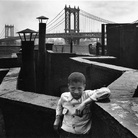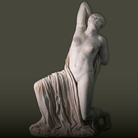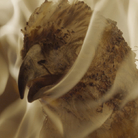Oneiros. Roberto Sebastian Matta tra Surrealismo e tecnologia

Roberto Sebastian Matta, Le grand inacheve, 1972, cm100x95,5
Dal 19 November 2015 al 6 February 2016
Milano
Luogo: Il Castello Modern and Contemporary Art
Indirizzo: via Brera 16
Orari: dal martedi al sabato 11-19 | lunedi 15-19
Curatori: Adriano Conte, Marcello Conte
Telefono per informazioni: +39 02 862913
E-Mail info: info@ilcastelloarte.it
Sito ufficiale: http://www.ilcastelloarte.it
Il 19 novembre inaugura alla galleria Il Castello di Milano una raffinata mostra con dipinti dell’artista cileno, Roberto Sebastian Matta (1911-2002), datati fra gli anni Cinquanta e i Duemila.
La sua è una storia avvincente, che passa da una giovanile collaborazione con Le Corbusier alla frequentazione e alla partecipazione al movimento surrealista, che ha segnato profondamente la sua ricerca.
Le sue prime opere, infatti, nascono dalla scrittura automatica. La figura umana, che troviamo in alcune dei dipinti qui in mostra, fa la sua comparsa a partire dal 1942, quando l’artista dà vita a un suo mondo, immediatamente riconoscibile, che si colloca in una dimensione futuribile. Un mondo in cui pare di scorgere una sorta di primitivismo di matrice tecnologica.
Sottili e complessi sono, inoltre, i riferimenti di natura psicologica, che fanno riferimento alla vita dell’uomo moderno in una sorta di modernità liquida, decisamente in anticipo sui tempi. Le opere in mostra, alcune di grande formato, riescono perfettamente a delinearne la personalità multiforme, tra le più interessanti del XX secolo.
Matta era convinto, come ha scritto lo storico dell’arte Giuliano Briganti, nel 1992, che: «L’arte è qualcosa che deve aiutare a diventare, non a essere, a essere cioè qualcosa di diverso da quello che si è, a trasmettere una spinta vitale così forte che fa cambiare». Un artista, dunque, capace di comprendere che il senso della propria ricerca non è quello di offrire delle risposte certe, ma di scatenare delle domande, delle questioni, diverse per ciascuno.
Il suo lavoro è stato oggetto di mostre personali in alcuni fra i più importanti musei del mondo da New York a Boston, da Berlino a Stoccolma. Il suo lavoro, all’inizio degli anni Settanta, ha fatto parte della grande mostra itinerante Per il Chile, che ha segnato un’importante risposta dell’arte nei confronti dell’avvento della dittatura nel suo paese d’origine. Negli anni Trenta ha vissuto a Parigi, per poi dividersi tra la capitale francese e il nostro paese, dove è scomparso, a Civitavecchia, nel 2002.
Angela Madesani.
La sua è una storia avvincente, che passa da una giovanile collaborazione con Le Corbusier alla frequentazione e alla partecipazione al movimento surrealista, che ha segnato profondamente la sua ricerca.
Le sue prime opere, infatti, nascono dalla scrittura automatica. La figura umana, che troviamo in alcune dei dipinti qui in mostra, fa la sua comparsa a partire dal 1942, quando l’artista dà vita a un suo mondo, immediatamente riconoscibile, che si colloca in una dimensione futuribile. Un mondo in cui pare di scorgere una sorta di primitivismo di matrice tecnologica.
Sottili e complessi sono, inoltre, i riferimenti di natura psicologica, che fanno riferimento alla vita dell’uomo moderno in una sorta di modernità liquida, decisamente in anticipo sui tempi. Le opere in mostra, alcune di grande formato, riescono perfettamente a delinearne la personalità multiforme, tra le più interessanti del XX secolo.
Matta era convinto, come ha scritto lo storico dell’arte Giuliano Briganti, nel 1992, che: «L’arte è qualcosa che deve aiutare a diventare, non a essere, a essere cioè qualcosa di diverso da quello che si è, a trasmettere una spinta vitale così forte che fa cambiare». Un artista, dunque, capace di comprendere che il senso della propria ricerca non è quello di offrire delle risposte certe, ma di scatenare delle domande, delle questioni, diverse per ciascuno.
Il suo lavoro è stato oggetto di mostre personali in alcuni fra i più importanti musei del mondo da New York a Boston, da Berlino a Stoccolma. Il suo lavoro, all’inizio degli anni Settanta, ha fatto parte della grande mostra itinerante Per il Chile, che ha segnato un’importante risposta dell’arte nei confronti dell’avvento della dittatura nel suo paese d’origine. Negli anni Trenta ha vissuto a Parigi, per poi dividersi tra la capitale francese e il nostro paese, dove è scomparso, a Civitavecchia, nel 2002.
Angela Madesani.
SCARICA IL COMUNICATO IN PDF
COMMENTI

-
 Dal 2 December 2025 al 19 February 2026
Milano | Centro Culturale di Milano
Dal 2 December 2025 al 19 February 2026
Milano | Centro Culturale di Milano
Walter Rosenblum. Il mondo e la tenerezza
-
 Dal 30 November 2025 al 12 April 2026
Gallarate | Museo MA*GA
Dal 30 November 2025 al 12 April 2026
Gallarate | Museo MA*GA
Kandinsky e l’Italia
-
 Dal 29 November 2025 al 12 April 2026
Roma | Musei Capitolini
Dal 29 November 2025 al 12 April 2026
Roma | Musei Capitolini
La Grecia a Roma
-
 Dal 22 November 2025 al 3 May 2026
Torino | Sale Chiablese dei Musei Reali
Dal 22 November 2025 al 3 May 2026
Torino | Sale Chiablese dei Musei Reali
Orazio Gentileschi. Un pittore in viaggio
-
 Dal 20 November 2025 al 25 January 2026
Firenze | Palazzo Strozzi
Dal 20 November 2025 al 25 January 2026
Firenze | Palazzo Strozzi
Andro Eradze. Bones of Tomorrow
-
 Dal 21 November 2025 al 28 March 2026
Cuneo | Complesso Monumentale di San Francesco
Dal 21 November 2025 al 28 March 2026
Cuneo | Complesso Monumentale di San Francesco
La Galleria Borghese. Da Raffaello a Bernini. Storia di una collezione


